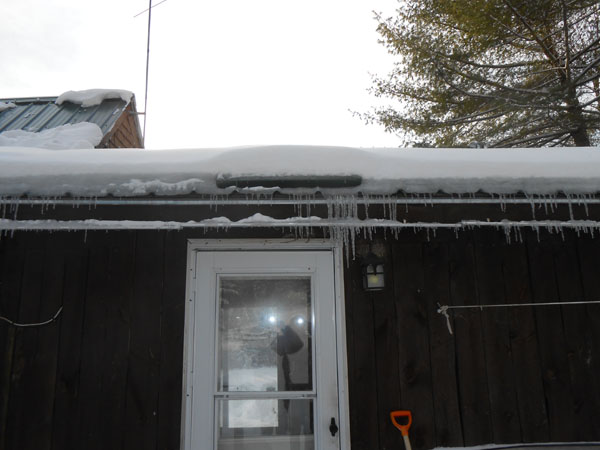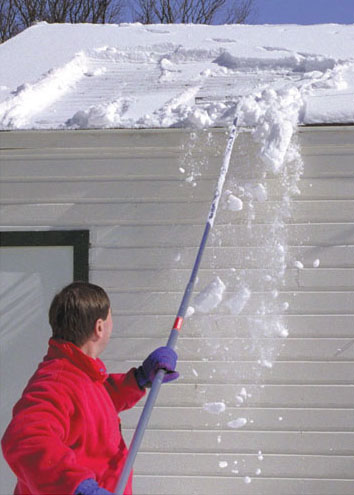Ice Dams — Their Cause And Prevention
 Ice dams form when heat escaping from inside a building melts snow on the overhang of a roof. If left unattended, this freezes each night, becoming thicker and thicker. Then at some point, water backs up under shingles and finds its way inside the house, causing damage to sheetrock walls, ceilings, and insulation. Repair costs can run into the thousands of dollars.
Ice dams form when heat escaping from inside a building melts snow on the overhang of a roof. If left unattended, this freezes each night, becoming thicker and thicker. Then at some point, water backs up under shingles and finds its way inside the house, causing damage to sheetrock walls, ceilings, and insulation. Repair costs can run into the thousands of dollars.
Homeowners need to take a proactive approach to ice buildup on roofs. Removing ice dams is always far more difficult than preventing them. Fortunately, we have a number of defense tricks at our disposal. Let’s discuss a few.
Roof Rakes
 Roof rakes won’t work for everyone, since some roofs are simply too high to reach with even the longest rake. Besides, using roof rakes to remove snow from roofs in order to prevent ice dams is physically demanding. But for those able and willing to get out there after each snow and remove at least three feet of snow up from the edge of the roof, roof rakes represent an inexpensive and efficient way to thwart ice dam damage.
Roof rakes won’t work for everyone, since some roofs are simply too high to reach with even the longest rake. Besides, using roof rakes to remove snow from roofs in order to prevent ice dams is physically demanding. But for those able and willing to get out there after each snow and remove at least three feet of snow up from the edge of the roof, roof rakes represent an inexpensive and efficient way to thwart ice dam damage.
A few caveats regarding roof rakes. Using a roof rake to chop existing ice can destroy asphalt shingles, diminishing their effectiveness and allowing water to work its way in. Even when used judiciously, the metal edge of a roof rake can cause premature shingle wear. The answer here comes in the form of the homeowner’s best friend – duct tape. Just install a thick layer of duct tape on the bottom edge of a roof rake and it will easily glide over shingles rather than digging in to them.
Finally, dress appropriately when pulling snow off a roof with a roof rake. Often, large cakes of snow come down with a big “whoosh.” Anyone standing under this will become snow covered. To prevent this, hold the rake handle at a slight angle, placing yourself away from any snow coming off the roof in the first place.
During winters with little snow, this snow that comes off a roof has real worth. It can serve as banking for a house foundation. The addition of one or more feet of snow snug around a house can raise the inside temperature by several degrees, thus helping to cut fuel costs.
Salt Socks
In cases where a roof, or a section of roof, isn’t reachable from the ground with a roof rake, a “salt sock” can serve admirably to keep ice dams from forming. To make a salt sock, just fill a long winter sock with rock salt. Or better yet, sew or have someone sew, a 4-foot section of tubular material. This should be closed on one end and open at the other, to facilitate filling with salt. Use a stout cord to tie the end closed after filling.
With salt socks ready, place each one flat on the roof three or four feet above the drip edge, and even with it. Do this in late fall, before the first snow. As moisture causes the salt to melt, it will slowly seep out, providing a protective coating of salt on the roof, preventing ice dam formation. A well-filled salt sock should perform for an entire winter season.
An online search will yield several manufacturers of salt socks, or tubes. But since they are so easy to produce at home, it makes little sense to pay money for them.
Metal Roofs
If these measures seem overly ambitious, then the next logical step would be to install a metal roof. Being fairly light, these can often go on top of existing shingles, making for easy installation. Metal roofing solves the problem of roof dams once and for all.
Still, snow and resulting ice can and does build up on metal roofs, especially on those with insufficient pitch for snow to simply slide off on its own. Also, north-facing roofs get little warmth from the sun and snow remains on these far longer than on south-facing roofs. This does not represent an ice dam problem, since as long as the metal roofing extends to the very end of the drip edge, ice cannot find its way beneath it and into the house.
But this ice buildup can cause irritating dripping, especially when gutters become clogged with ice and no longer function as they should. And when dripping occurs over a door and freezes on the ground, it can present a safety problem. The answer in this case comes in the form of a snow diverter over the door.
A homemade snow diverter can consist of almost any material, from wooden two-by-fours nailed flat on the roof above the doorway, to short sections of metal roofing material folded into a tent shape and screwed down on the roof above the door. And even when heavy snow tries to rip the diverter off the roof, which sometimes happens, the thing continues to work even when severely bent, as long as it remains in place.
These are only some of the ways in which we can circumvent damage from ice dams. It doesn’t make much difference which method you choose, as long as you attend to the situation before it becomes a problem. An ounce of prevention, in this case, is worth many pounds of cure.
Want to learn more about the DR Power Equipment line-up?
Order your FREE catalog!

What's inside
- Information about the full line of DR equipment
- Money-saving promotions
- Product ordering information